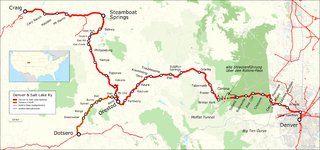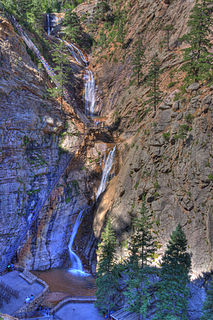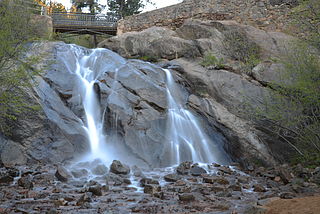Related Research Articles

Winfield Scott Stratton was an American prospector, capitalist, and philanthropist. He discovered the Independence Lode near Victor, Colorado on July 4, 1891, and became the Cripple Creek Mining District's first millionaire in 1894. He provided to build buildings, improve the street car system, build the first professional ball park, and provided funds to people in need.

The Denver and Salt Lake Railway (D&SL) was a U.S. railroad company located in Colorado. Originally incorporated in 1902 as the Denver, Northwestern and Pacific (DN&P) Railway, it had as a goal a direct connection of Denver, Colorado, with Salt Lake City, Utah. It underwent numerous reorganizations throughout its financially troubled history and by the time the company was acquired in 1931 by the Denver and Rio Grande Western Railroad, it had advanced only as far as Craig, Colorado. After the acquisition the line was connected to the D&RGW main, and the eastern half of the line was used to give the D&RGW a more direct route to Denver. The portions of the railroad still in use today are known as the Moffat Tunnel Subdivision of Union Pacific Railroad's Central Corridor. Amtrak’s California Zephyr service from Denver to Glenwood Springs follows much of the old D&SL route.

The Broadmoor Seven Falls is a series of seven cascading waterfalls of South Cheyenne Creek in South Cheyenne Cañon, Colorado Springs, Colorado. It has been a privately-owned tourist attraction since it was opened in the early 1880s.

The Colorado and Southern Railway was an American Class I railroad in the western United States that operated independently from 1898 to 1908, then as part of the Chicago, Burlington and Quincy Railroad until it was absorbed into the Burlington Northern Railroad in 1981.

Cascade is an unincorporated community and U.S. Post Office in El Paso County, Colorado, United States. The ZIP Code of the Cascade Post Office is 80809.

Before it was founded, the site of modern-day Colorado Springs, Colorado, was part of the American frontier. Old Colorado City, built in 1859 during the Pike's Peak Gold Rush was the Colorado Territory capital. The town of Colorado Springs, was founded by General William Jackson Palmer as a resort town. Old Colorado City was annexed into Colorado Springs. Railroads brought tourists and visitors to the area from other parts of the United States and abroad. The city was noted for junctions for seven railways: Denver and Rio Grande (1870), Denver and New Orleans Manitou Branch (1882), Colorado Midland (1886-1918), Colorado Springs and Interurban, Atchison, Topeka, and Santa Fe (1889), Rock Island (1889), and Colorado Springs and Cripple Creek Railways. It was also known for mining exchanges and brokers for the Cripple Creek Gold Rush.
Ivywild, Colorado, is a subdivision of Colorado Springs south of the downtown, west of Cascade Avenue and along Cheyenne Creek. As of 2015, the United States Geological Survey defines Ivywild as a Populated Place. It is one of the city's oldest working-class neighborhoods.

Manitou Springs Historic District in Manitou Springs, Colorado is roughly bounded by US 24, Ruxton Avenue, El Paso Boulevard and Iron Mountain Avenue. Listed in the National Register of Historic Places, it is one of the country's largest National Historic Districts.

Manitou Mineral Springs are natural mineral springs in Manitou Springs, Colorado and Cheyenne Spring House is on the National Register of Historic Places. The springs are located in one of the country's largest National Historic Districts.

North Cheyenne Cañon Park or North Cheyenne Canyon Park is a regional park located in Colorado Springs, Colorado. It is a National Register of Historic Places listing.

There are a wide range of recreational areas and facilities in Colorado Springs, Colorado.

Iron Springs, a neighborhood in Manitou Springs, Colorado, was an area named for one of Manitou Mineral Springs. The Manitou area had been frequented by Native Americans who considered it a sacred and healing place before European Americans settled in Manitou.
Englemann Canyon is a valley along Ruxton Creek, in Manitou Springs, El Paso County, Colorado. It is one of three canyons in Manitou Springs, the others are Ute Pass and Williams Canyon.
Camp Harding was a summer resort with boarding house west of Broadmoor Park "at the mouth of Cheyenne canon" that was one of several early 20th century health facilities in the area Anna E Harding was the 1903 proprietor of the facility on W Cheyenne Road, which was through the gate with gatekeeper for the "carriage-way to the Cheyenne canons" with a "rustic bridge" to Camp Harding's "red roof" structures and pine trees. Camp Harding had a single-story cottage, c. seven tents, and a 2-story brick home with striped porch awning, and the camp was named in a 1912 Long Island, New York, divorce case. The area is now part of the Colorado Springs metropolitan area.

The Colorado Springs and Interurban Railway was an electric trolley system in the Colorado Springs, Colorado that operated from 1902 to 1932. The company was formed when Winfield Scott Stratton purchased Colorado Springs Rapid Transit Railway in 1901 and consolidated it in 1902 with the Colorado Springs & Suburban Railway Company. It operated in Colorado Springs, its suburbs, and Manitou Springs. One of the street cars from Stratton's first order is listed on the Colorado State Register of Historic Properties.

South Cheyenne Cañon, or South Cheyenne Canyon, is a canyon in Colorado Springs, El Paso County, Colorado. The South Cheyenne Cañon road to Seven Falls is called "The Grandest Mile of Scenery" in Colorado. Seven Falls has been a tourist attraction since it was opened in the early 1880s. Trails from the top of the falls lead to Midnight Falls, near the headwaters of South Cheyenne Creek, and Inspiration Point. The area has been a center for parks, such as the Stratton Park and Colorado College Park. Now, part of South Cheyenne Cañon, including the Starsmore Discovery Center, is in the North Cheyenne Cañon Park. The area sustained a significant flood in September 2013, which closed Seven Falls until Spring 2015. Presently the falls are open again.

Seven Lakes is an abandoned, historical populated place in Teller County, Colorado on the Pikes Peak mountain. It was once the site of the Seven Lakes Hotel along a carriage road to the summit of Pikes Peak. Its waters flow from Beaver Creek to the Lake Moraine reservoir, a supplier of water to Colorado Springs.

Cheyenne Creek is a stream in Colorado Springs, El Paso County, Colorado at 5,920 feet (1,800 m) in elevation. The stream is fed by the North Cheyenne Creek and South Cheyenne Creek and flows into Fountain Creek near Nevada Avenue, between Interstate 25 and the Pikes Peak Greenway trail. North Cheyenne Creek and South Cheyenne Creek flow through Teller and El Paso Counties. The source of South Cheyenne Creek is Mount Big Chief, near St. Peter's Dome, and it flows to Seven Falls.

Cheyenne Mountain is a triple-peaked mountain in El Paso County, Colorado, southwest of downtown Colorado Springs. The mountain serves as a host for military, communications, recreational, and residential functions. The underground operations center for the North American Aerospace Defense Command (NORAD) was built during the Cold War to monitor North American airspace for missile launches and Soviet military aircraft. Built deep within granite, it was designed to withstand the impact and fallout from a nuclear bomb. Its function broadened with the end of the Cold War, and then many of its functions were transferred to Peterson Air Force Base in 2006.
References
- 1 2 3 4 5 "The History of the Colorado P.E.O. Chapter House". P.E.O. Chapter House. 2005. Archived from the original on February 1, 2015. Retrieved January 16, 2015.
- 1 2 3 Allan C. Lewis (2006). Railroads of the Pike's Peak Region, 1900-1930. Arcadia Publishing. ISBN 978-0-7385-3125-0.
- 1 2 "Colorado Springs, Colorado". Electric Railway Review. Vol. XIII. Chicago: Windsor and Kenfield Publishing House. 1903. p. 147.